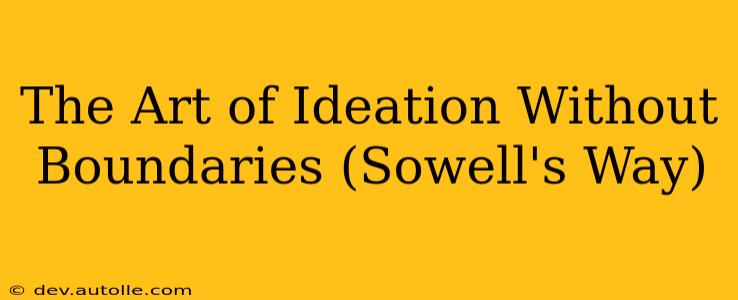Thomas Sowell, the renowned economist and social theorist, didn't just analyze society; he shaped thought. While not explicitly outlining a "Sowell Method" for ideation, his prolific output and intellectual rigor reveal a powerful approach to generating groundbreaking ideas, free from conventional constraints. This article explores the essence of Sowell's approach, highlighting key principles that can unlock your own boundless ideation. We'll delve into how to cultivate his intellectual mindset, leveraging his strategies to unleash your creative potential.
What is Sowell's Approach to Ideation?
Sowell's method isn't a rigid formula but a philosophy built on intellectual humility, rigorous analysis, and a deep understanding of history and disparate perspectives. He emphasizes the importance of questioning assumptions, considering unintended consequences, and avoiding intellectual biases. This results in a remarkably open and boundary-less approach to generating and evaluating ideas. It's about thinking critically and creatively, examining issues from multiple angles before forming conclusions.
Understanding the Importance of Diverse Perspectives (A Key Sowell Principle)
Sowell's work constantly emphasizes the necessity of understanding diverse perspectives. He highlights how different groups and individuals, based on their unique experiences and circumstances, have fundamentally different understandings of the world. This understanding is crucial for generating truly innovative ideas. By consciously seeking out viewpoints that contradict our own, we challenge our preconceived notions and open ourselves to new possibilities.
How to Apply Sowell's Ideation Principles: A Practical Guide
1. Embrace Intellectual Humility: Sowell consistently demonstrates an understanding that he doesn't possess all the answers. This openness to being wrong, or at least partially wrong, is crucial for generating new ideas. Start by acknowledging the limits of your own knowledge and be prepared to revise your thinking as you gather more information.
2. Master the Art of Comparative Analysis: Sowell masterfully compares and contrasts different systems, societies, and policies. He draws parallels and highlights differences, revealing underlying mechanisms and hidden assumptions. To apply this, learn to compare seemingly disparate ideas, seeking connections and contrasts that spark new insights.
3. Focus on Unintended Consequences: Sowell's analyses frequently reveal the unintended, often negative, consequences of well-intentioned policies and actions. When generating ideas, actively consider the potential ripple effects, both positive and negative. This anticipatory thinking can lead to more robust and effective solutions.
4. Challenge Assumptions: Sowell rigorously challenges underlying assumptions—both his own and those prevalent in society. This critical questioning is vital for innovative thought. Before accepting any idea as truth, examine its foundational assumptions. Ask "Why?" repeatedly until you reach the core premises.
5. Historical Context is Crucial: Sowell's deep understanding of history informs his analyses. He shows how current events are shaped by past decisions and social forces. Always consider the historical context when generating ideas. What lessons can be learned from the past? How do historical patterns inform current challenges?
Frequently Asked Questions (FAQs)
How can I apply Sowell's approach in my daily life?
Start by consciously challenging your own assumptions about everyday situations. Look for alternative explanations and perspectives. Read widely and engage with diverse viewpoints, seeking out those that challenge your existing beliefs.
Is Sowell's approach applicable to all fields?
Yes. The principles of intellectual humility, comparative analysis, and consideration of unintended consequences are universally applicable, from scientific research to business strategy to personal decision-making.
What are some common pitfalls to avoid when using Sowell's method?
Avoid confirmation bias – actively seek out information that contradicts your initial ideas. Don't get bogged down in analysis paralysis – after careful consideration, make a decision and move forward.
Can Sowell's approach help me become more creative?
Absolutely. By breaking free from preconceived notions and embracing diverse perspectives, you open up a vast landscape of possibilities, fueling creativity and leading to innovative solutions.
How can I improve my ability to consider unintended consequences?
Practice "scenario planning" – imagine various potential outcomes of your ideas, both positive and negative. Engage in discussions with others to get diverse perspectives on the potential consequences of your proposals.
By embracing the principles outlined above, you can cultivate a Sowell-esque approach to ideation. Remember that this is a journey, not a destination. The more you practice these techniques, the more adept you will become at generating innovative and insightful ideas without boundaries.

